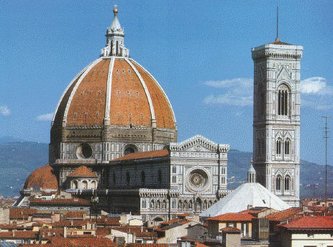Santa Maria del Fiore
|
|
Lightmatter_Santa_Maria_del_Fiore_2.jpg
Lightmatter_Santa_Maria_del_Fiore.jpg
The Basilica di Santa Maria del Fiore (also known as The Duomo) is the cathedral church of the Roman Catholic Archdiocese of Florence, noted for its distinctive dome. Its name (which translates as "Saint Mary of the Flower") refers to the lily, symbol of Florence. The cathedral complex includes the Duomo, the baptistery and the campanile (bell tower)
The cathedral, the third to be built in Florence, was built on the site of the previous one, Santa Reparata, prompted by the magnificence of the new cathedrals in Pisa and Siena. It was designed by Arnolfo di Cambio in 1294 to be the largest Roman Catholic church in the world (although the design was later reduced in size), with the first stone being laid on 1296-09-08. After Arnolfo died in 1302, work on the cathedral slowed. In 1331, the Arte della Lana (Guild of Wool Merchants) took over responsibility for the construction of the cathedral and in 1334 they appointed Giotto as overseer for the work. His major accomplishment was the campanile, but he died in 1337. It was not until 1355 that work resumed on the cathedral itself under a series of architects, including Francesco Talenti, Alberto Arnoldi, Giovanni d'Ambrogio, Giovanni di Lapo Ghini, Neri di Fioravante and Orcagna. The nave was finished by 1380, and by 1418 only the dome was uncompleted.
In 1418 a competition was held to design a new dome (or cupola) for the cathedral. The two competitors were Lorenzo Ghiberti and Filippo Brunelleschi. Brunelleschi won the competition with his distinctive octagonal design, but both were appointed architects. This did not work, and Brunelleschi soon took over sole responsibility. Work started on the dome in 1420 and was completed in 1436; the cathedral was consecrated by Pope Eugenius IV on 1436-03-25. It was the first 'octagonal' dome in history (The Roman Pantheon, a circular dome, was built in 118-128 C.E. without support structures) to be built without a wooden supporting frame, and was the largest dome built at the time (it is still the largest masonry dome in the world). Brunelleschi's ability to crown the dome with a lantern was questioned and he had to undergo another competition. The lantern was begun a few months before his death in 1446 and was completed by his friend Michelozzo. A huge statue of Brunelleschi now sits outside the Palazzo dei Canonici in the Piazza del Duomo, looking thoughtfully up towards his greatest achievement. The Dome also used horizontal reinforcements of tension chains of stone and iron - paving way to the imaginations of iron and steel structural reinforcements, such as reinforced concrete in later centuries.
The specially designed hoisting machines and brilliant masonry techniques were Brunelleschi's spectacular contribution to architecture. The ability to transcribe a circle within the double shelled wall makes the self-sustaining horizontal arch construction possible, since geometrically, a circular plan is needed for such an erection.
The cathedral's facade was demolished in 1587-1588 and was bare until the 19th century. In 1864 a competition was held to design a new facade and was won by Emilio De Fabris. Work was begun in 1876 and completed in 1887. The huge bronze doors date from 1899 to 1903.
The Gothic interior is cavernous and is particularly notable for its stained glass windows (mostly 1434-1445; some designed by Ghiberti) and its marble pavement (1526-1660).
Artists who have produced work for the cathedral include:
- Benedetto and Giuliano da Maiano (panelling in the sacristy)
- Andrea del Castagno (fresco of Niccolò da Tolentino on the north wall)
- Luca della Robbia (reliefs of the Resurrection and Ascension above the sacristy doors; work on the sacristy door with Michelozzo; choir loft, now in the Museo del Duomo)
- Domenico di Michelino (Dante Explaining the Divine Comedy on the north wall)
- Donatello (heads of a prophet and a sibyl on the south side of the exterior; choir loft, now in the Museo del Duomo)
- Davide and Domenico Ghirlandaio (mosaic of the Annunciation on the south side of the exterior)
- Michelozzo (work on the sacristy door, with Luca della Robbia)
- Nanni di Banco (relief of Assumption of the Virgin on south side of exterior)
- Paolo Uccello (decoration of west wall clock; fresco of Sir John Hawkwood on the north wall)
- Giorgio Vasari and Federigo Zuccaro (frescoes of The Last Judgement in the interior of the dome)
Links
- Structurae: Santa Maria del Fiore (http://www.structurae.net/en/structures/data/s0000294/index.cfm)de:Dom Santa Maria del Fiore
ja:サンタ・マリア・デル・フィオーレ大聖堂 nl:Santa Maria del Fiore pl:Katedra Santa Maria del Fiore

